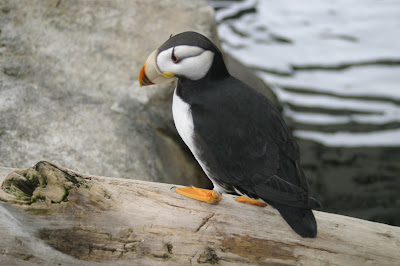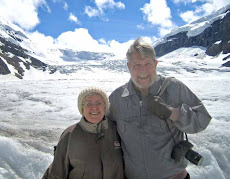We left Homer on Wednesday, June 18th, drove to Soldotna (60 miles), and spent the night at an unusual location—behind a laundromat—that had free WIFI. I had heard about this place, searched Google for the laundromats, called, and the first one told me to come on in. It worked just fine and we did a massive laundry, too! There were lots of RVs overnighting in the local Fred Meyer grocery as well.
Soldotna is famous for two things… The first is fish. The Kenai River runs through town and has bragging rights for producing the largest salmon caught on record (90+ pounds). The second is the "Moose is Loose" bakery! I am now another convert and spreading the word. It’s a big place with plenty of parking for the motorhome. Everyone is familiar with the normal glazed donut, right? They had glazed donuts and the chocolate-covered-glazed that one would barely fit on a normal dinner plate! Seriously! They also had taken caramel rolls, flattened them (so they were about a foot long and 8 inches across), baked them again to make them crispy, and named them "Road Kill Caramel Rolls!" Good stuff.
We departed Soldotna for a leisurely 50-60 mile drive to Seward—back on the coast—and arrived June 19th.
Seward


 We stayed in Seward Military Resort RV park on the edge of town. Nice park but water and electric only. This one is run by the Army and interestingly, it is across the street from another one run by the Air Force. This one is definitely nicer. Free WIFI but only at the lodge.
We stayed in Seward Military Resort RV park on the edge of town. Nice park but water and electric only. This one is run by the Army and interestingly, it is across the street from another one run by the Air Force. This one is definitely nicer. Free WIFI but only at the lodge.We docked in Seward on a couple of cruises up here but did not spend any time in the area back then. At the time, Princess took us on into Anchorage on busses. Cruise ships still dock here so the town expands and contracts with people (tourists). Since we have our car, we can bypass the main crowds from the ships and do our thing. After all, we don’t want to mess with tourists!
The original start of the Iditarod Race was in Seward. Now it has a commemorative start in Anchorage and a “restart” in Wasilla (remember me mentioning those giant vegetables in the Matanuska Valley—that’s Wasilla). I’m not sure why they have the restart.
From south central Alaska to Nome (on the western coast on the Bering Sea), each team of 12 to 16 dogs and their musher cover over 1,150 miles in 10 to 17 days. The Iditarod began in 1925 when part of the current Trail became a life-saving highway for epidemic-stricken Nome. Diphtheria threatened and serum had to be brought in. The only way to get it there was dog mushers and their hard-driving dogs.
 The Seward museum is a great place to start your visit and we learned that this was the first city in Alaska where ships could dock. It was a natural site for a city.
The Seward museum is a great place to start your visit and we learned that this was the first city in Alaska where ships could dock. It was a natural site for a city.There is information about the native Alaskans everywhere including a number of museums and, of course, in most other museums, too. One of the fascinating things we learned was due to the extreme cold and being forced to fish, how they brave the icy water and survive. Over time—and a long time ago—they learned to make a type of parka out of seal gut (seriously). This was sewn together in a special way that made it waterproof (we had the chance to view a video of them sewing so it is not a lost art). This parka is so waterproof that they can actually carry water in it!


 Seward has a large “public” campground along the bay (every site has a view of the bay and about half are on the water’s edge). These are boondocking only (no hookups). The city charges $15.00 per night to park there. It is a good deal and rigs were constantly moving in and out. You just put your money in the “Iron Ranger” and move in—two weeks max. A great view!
Seward has a large “public” campground along the bay (every site has a view of the bay and about half are on the water’s edge). These are boondocking only (no hookups). The city charges $15.00 per night to park there. It is a good deal and rigs were constantly moving in and out. You just put your money in the “Iron Ranger” and move in—two weeks max. A great view!


 The Alaska SeaLife Center is a non-profit marine science operation that is the only project authorized to rescue and rehabilitate animals. It was funded, in part, by the Exxon-Valdez oil spill funds. We had a behind-the-scenes tour that was excellent and spent some time feeding the birds, learning how they take care of them, and what they do with the data collected. The puffins are wonderful!
The Alaska SeaLife Center is a non-profit marine science operation that is the only project authorized to rescue and rehabilitate animals. It was funded, in part, by the Exxon-Valdez oil spill funds. We had a behind-the-scenes tour that was excellent and spent some time feeding the birds, learning how they take care of them, and what they do with the data collected. The puffins are wonderful!Cooper Landing
This tiny town is located between Seward and Soldotna and is known for… fish. The Kenai River runs through town before it gets to Soldotna and fishing is the primary activity. We stayed here because Princess Cruises owns five lodges in Alaska (and we are confirmed Princess customers with 22 cruises now). The lodge here in Cooper Landing also has an RV park. We just wanted to see/experience the facility and had no other agenda for coming here.
The RV park was nice, clean, with 3-way hookups (30 amp), but no frills (okay with us). It is about 100 yards from the lodge—a large log structure with the expected rooms, views, and amenities. There was a small, but busy, bar with a huge deck out back with an excellent view overlooking the Kenai River. They have a great restaurant in the lodge (as expected). But, there was nothing else there (for us) since we were not fishing.
Palmer
Going to Palmer meant leaving the Kenai Peninsula. Palmer is in the Matanuska Valley—the “growing region” known for its abundance and literally, huge vegetables. They grow rapidly due to the short season and long days. Due partially to a fine mix of glacial silt and loam, giant vegetables grow to an unearthly size in this Alaskan flood plain. Try to visualize broccoli 3 feet tall and 7 feet wide, celery so large you can't wrap your arms around a single bunch, 98-pound cabbages, and 25-pound mushrooms. We did not see any (too early in the year). Palmer is the home of the state fairgrounds and they show the veggies at the State Fair.
 I had stumbled across the Alaska Samboree (for the non-RV readers, a Samboree is a gathering of RVs whose members belong to the Good Sam Club—a popular RV organization—with every state having a chapter). It was held at the state fairgrounds, we signed up, and offered to do some seminars for their attendees. So our first four days in Palmer was with this group of RVers.
I had stumbled across the Alaska Samboree (for the non-RV readers, a Samboree is a gathering of RVs whose members belong to the Good Sam Club—a popular RV organization—with every state having a chapter). It was held at the state fairgrounds, we signed up, and offered to do some seminars for their attendees. So our first four days in Palmer was with this group of RVers.Palmer had several interesting tourist places to visit so we stayed an additional four days by just moving into a campground across the street from the fairgrounds. It worked. We visited the Reindeer Farm. The reindeer and the caribou are the same animal—called caribou in the wild and reindeer in captivity.
 We also visited a Musk Ox farm. This huge (1,000 pounds) animal is one ugly dude but they have two claims to fame. First, they shed one of the world’s finest, softest, and most expensive “wools” called “Qiviut.” How expensive? One ball of the Qiviut (just like a normal ball of yarn) was priced at $90.00! It’s woven just like yarn but is eight times warmer than sheep’s wool, lighter weight, and won’t shrink. The second claim is that although the Musk Ox is a hoofed animal, they are the northernmost species in the world. They can live and survive in –70° (that’s 70-BELOW-zero) weather.
We also visited a Musk Ox farm. This huge (1,000 pounds) animal is one ugly dude but they have two claims to fame. First, they shed one of the world’s finest, softest, and most expensive “wools” called “Qiviut.” How expensive? One ball of the Qiviut (just like a normal ball of yarn) was priced at $90.00! It’s woven just like yarn but is eight times warmer than sheep’s wool, lighter weight, and won’t shrink. The second claim is that although the Musk Ox is a hoofed animal, they are the northernmost species in the world. They can live and survive in –70° (that’s 70-BELOW-zero) weather.We were also able to wash our coach at the campsite in this campground. A 3-4 hour job but luckily, the weather is wonderful. It was near 65° that day!



No comments:
Post a Comment